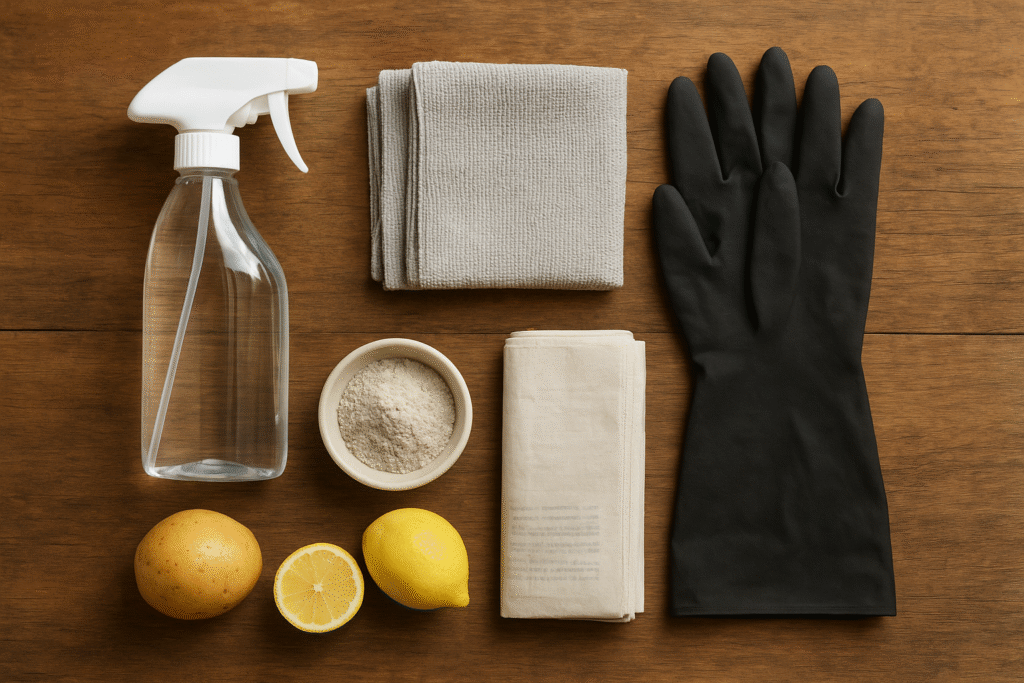Introduction
If you’ve owned a wood stove for more than a single winter, you’ve probably faced the glass problem. You know when that once-clear view of your cozy flames turns into a smoky haze or full-on soot blackout. For years, I used to grab the strongest store-bought cleaner I could find. But after one too many coughing fits and a nagging suspicion I was doing my stove (and myself) no favors, I decided to learn how to clean wood stove glass without chemicals.
Over the past 15 years of wood stove ownership, I’ve tried just about every natural method you can think of. Some worked brilliantly, others… let’s just say my glass and I both learned lessons the hard way. Today, I’m going to share the best ways to get crystal-clear wood stove glass without touching a single chemical spray bottle.
In this guide, we’ll cover:
- Why you should skip chemical cleaners altogether
- How soot and creosote build up in the first place
- Five tried-and-true natural cleaning methods
- The tools and materials you’ll need
- Safety precautions
- Maintenance tips to reduce cleaning frequency
- Troubleshooting stubborn buildup
- FAQs from fellow wood stove owners
By the end, you’ll know exactly how to clean wood stove glass without chemicals to keep your view of the fire sharp and clean using only safe, eco-friendly methods.
Why Avoid Chemical Cleaners?

When I first started with my old cast iron Jøtul stove, I didn’t think twice about using chemical sprays. But over time, three big reasons convinced me to ditch them.
Health Concerns
When you spray a chemical cleaner onto warm glass (even slightly warm), it can release fumes into your home. Some glass cleaners contain ammonia or solvents that aren’t great for lungs especially in winter, when we tend to have less ventilation. If you have kids, pets, or asthma sufferers in your home, the risk is even higher. One reason I began researching how to clean wood stove glass without chemicals was to protect my family’s air quality.
Environmental Impact
Chemical cleaners don’t just vanish after you wipe them off. Residue can drip into your ash pan, mix with creosote, and eventually be disposed of outdoors. Over time, these compounds can find their way into soil or water systems. Using natural wood stove glass cleaner methods means you’re keeping it simple and safe for the environment.
Stove Component Damage
Some chemical cleaners are surprisingly harsh. Ammonia-based products, for example, can degrade certain gaskets and even etch the glass if used repeatedly on hot surfaces. In my early years, I learned this the hard way when a cleaner caused faint streak-like etching that never came out.
Cost Effectiveness
Let’s be honest, chemical sprays aren’t cheap, especially if you’re cleaning weekly. Natural, chemical free stove glass cleaning methods often use materials you already have on hand like wood ash, vinegar, or even a potato.
Understanding Wood Stove Glass and Buildup
What Causes the Buildup?
Wood stove glass isn’t just regular glass it’s usually a ceramic glass designed to handle high heat. But over time, soot (carbon particles) and creosote (a sticky byproduct of wood combustion) can cling to the inside.
Factors that make buildup worse:
- Burning unseasoned or damp wood
- Low-temperature burns
- Poor airflow or draft
- Extended periods without cleaning
Types of Buildup
- Light haze: Usually just soot, comes off easily with a quick wipe
- Sticky brown or black: Likely creosote, harder to remove
- White haze: Often from mineral deposits if moisture hits hot glass
Signs You Need to Clean
If you can’t clearly see the flames, or if your glass looks foggy even when the stove is off and cool, it’s time to clean. I usually tell people: if you notice it, it’s already overdue.
Prevention Tips
- Burn seasoned hardwoods
- Keep stove temperatures above 500°F for a portion of each burn
- Ensure adequate airflow
- Clean ash regularly
Knowing why your glass gets dirty helps you pick the best way to clean wood stove glass without chemicals and prevent it from getting so bad in the first place.
Tools and Materials You’ll Need
Before diving into the cleaning process, it’s important to gather the right tools and materials to make your job easier and more effective. When learning how to clean wood stove glass without chemicals, having simple, everyday items on hand can save you time and hassle. Luckily, most of what you need is already in your kitchen or garage. From natural abrasives like wood ash to gentle scrubbing cloths, these essentials will help you achieve spotless stove glass safely and naturally.
Essentials:

- Spray bottle
- Microfiber cloths
- Gloves
- Bowl for ash
- Newspaper
Natural Ingredients:

- Wood ash
- Vinegar
- Lemon
- Salt
- Potato
- Baking soda
Natural Cleaning Methods
After years of testing, here are my top five natural methods on how to clean wood stove glass without chemicals solutions.

Method 1: Wood Ash Technique
Materials:
- Damp paper towel or rag
- Cool, fine wood ash (avoid big chunks)
- Gloves (optional)
Steps:
- Wait until the stove is completely cool.
- Dip your damp cloth into the ash.
- Gently rub the ash over the soot-covered glass in small circles.
- Wipe away residue with a clean damp cloth.
- Buff dry with a soft rag.
Why It Works:
Ash contains fine, natural abrasives that scrub without scratching. It also has mild alkaline properties that help dissolve creosote.
Pro Tip:
Use ash from hardwoods, it’s finer and works better than softwood ash.
Method 2: Vinegar and Water Solution
Materials:
- Spray bottle
- 50/50 mix of white vinegar and water
- Microfiber cloth
Steps:
- Spray the cooled glass lightly.
- Let sit for 1–2 minutes.
- Wipe in a circular motion with microfiber.
- Repeat for stubborn spots.
Why It Works:
Vinegar is acidic, which helps dissolve soot and creosote residue. It’s also safe and inexpensive.
Best For:
Light to moderate soot, routine cleaning.
Method 3: Newspaper and Ash Method
This old-school favorite still works wonders.
Materials:
- Sheet of newspaper
- Small bowl of wood ash
- Water
Steps:
- Crumple the newspaper.
- Dampen it slightly.
- Dip into ash.
- Rub glass in circular motion.
- Wipe clean with dry newspaper.
Results:
It’s oddly satisfying plus, you’re recycling.
Method 4: Lemon and Salt Scrub
Materials:
- Halved lemon
- Coarse salt
- Small bowl
Steps:
- Sprinkle salt on lemon half.
- Rub over soot buildup.
- Wipe clean with damp cloth.
Why It Works:
The lemon’s acidity plus salt’s abrasiveness tackle stubborn spots.
Caution:
Rinse well citric acid shouldn’t be left on glass too long.
Method 5: Potato Method
Materials:
- Raw potato, halved
- Baking soda (optional for mild abrasion)
Steps:
- Dip cut potato in baking soda.
- Rub glass in small circles.
- Wipe with damp cloth.
Why It Works:
Potato juice contains oxalic acid, which helps loosen stains. It’s surprisingly effective on smoky haze.
Safety Precautions and Best Practices
- Always clean when the stove is fully cool. avoid metal scrapers, and follow how to clean wood stove glass without chemicals best practices to prevent damage.
- Wear gloves to protect from soot stains.
- Work in a well-ventilated area.
- Avoid using metal scrapers, they can scratch the glass.
- If buildup won’t budge, call a professional.
For more safety guidance, check the NFPA wood stove safety recommendations.
6. Maintenance Tips to Reduce Cleaning Frequency

- Burn seasoned wood (see our guide to Best Wood Types for Clean Burning).
- Maintain hot burns for at least part of each fire.
- Empty ash pan regularly to improve airflow.
- Schedule seasonal stove maintenance.
- Use smaller, hotter fires to reduce creosote.
The EPA’s wood stove guidelines have excellent tips on efficient burning.
Troubleshooting Common Issues
- Stubborn Buildup: Try ash + vinegar mix for extra cleaning power.
- Scratched Glass: Only use soft cloths, avoid abrasives like sandpaper.
- Still Cloudy After Cleaning: Check for mineral etching, this may be permanent.
- Natural Methods Fail: If you can’t clean it after multiple tries, have a stove tech inspect for glass replacement.
FAQs about How to Clean Wood Stove Glass Without Chemicals
How often should I clean my wood stove glass using natural methods?
For most households, every 1–2 weeks in active burning season. Frequency depends on wood quality and burn habits.
Can I use baking soda to clean wood stove glass without chemicals?
Yes. Make a paste with water and gently scrub. Baking soda is mildly abrasive and safe for glass.
What’s the most effective natural method for heavily sooted glass?
The wood ash method is the best first try, followed by lemon + salt for stubborn spots.
Are there any natural cleaning methods I should avoid?
Avoid sharp abrasives like sand or metal wool. They can scratch glass permanently.
Conclusion
Learning how to clean wood stove glass without chemicals has saved me money, kept my home healthier, and made winter nights by the fire that much better. Whether you use the simple wood ash trick, a vinegar spray, or even the humble potato, you can keep your stove glass clear without harsh products.
Stay consistent, burn the right wood, and follow safe cleaning practices, you’ll spend more time enjoying the fire and less time fighting the soot.





